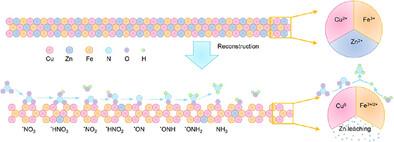层状双氢氧化物的三元协同作用对硝酸盐的有效和稳定还原
IF 19
1区 材料科学
Q1 CHEMISTRY, MULTIDISCIPLINARY
引用次数: 0
摘要
农业径流和工业排放的硝酸盐污染造成严重的环境和健康风险,需要可持续的补救措施。电催化硝酸还原反应(NO3RR)是一种很有前途的解决方案,它将硝酸盐转化为氨,需要具有高活性和选择性的催化剂。本文报道了层状双氢氧化物(LDHs)通过组成工程和原位重建可以获得高效的NO3RR性能。研究表明,CuZnFe三元LDH催化剂可以利用协同效应和可控的表面重构,高效稳定地将硝酸盐还原为氨。在NO3RR过程中,铜化合物被还原为金属态以增强活性,重建的氧化铁稳定了结构并提高了活性,锌被选择性浸出以暴露活性位点。原位ATR-FTIR光谱显示,金属铜启动硝酸盐到亚硝酸盐的转化,而氧化铁驱动氨的形成。结果,该催化剂对氨的法拉第效率达到95%,氨的产率为51 mg h - 1 cm - 2,电流密度为0.64 a cm - 2,相对于RHE为- 0.9 V,稳定性高。该研究结果为NO3RR机理的深入理解提供了新的思路,并通过原位重构和组合工程设计了用于硝酸盐高级修复的串联催化剂。本文章由计算机程序翻译,如有差异,请以英文原文为准。

Ternary Synergy in Layered Double Hydroxides for Efficient and Stable Nitrate Reduction
Nitrate pollution from agricultural runoff and industrial discharge poses severe environmental and health risks, necessitating sustainable remediation. Electrocatalytic nitrate reduction reaction (NO3RR) offers a promising solution by converting nitrate to ammonia, where catalysts with high activity and selectivity are needed. Here, it is reported that layered double hydroxides (LDHs) can achieve highly efficient NO3RR performance through composition engineering and in situ reconstruction. It is shown that a ternary CuZnFe LDH catalyst can leverage synergistic effects and controlled surface reconstruction for highly efficient and stable reduction of nitrate to ammonia. During NO3RR, copper compound is reduced to a metallic state for enhanced activity, reconstructed iron oxide stabilizes the structure and improves the activity, and zinc is selectively leached to expose active sites. In situ ATR-FTIR spectroscopy reveals that metallic copper initiates nitrate-to-nitrite conversion, while iron oxide drives ammonia formation. As a result, the catalyst achieves a Faraday efficiency of 95% for ammonia, an ammonia yield of 51 mg h⁻1 cm⁻2, a current density of 0.64 A cm⁻2 at −0.9 V vs. RHE, and high stability. The findings provide an insightful understanding on the NO3RR mechanism, novel strategies for the design of tandem catalysts through in situ reconstruction and composition engineering for advanced nitrate remediation.
求助全文
通过发布文献求助,成功后即可免费获取论文全文。
去求助
来源期刊

Advanced Functional Materials
工程技术-材料科学:综合
CiteScore
29.50
自引率
4.20%
发文量
2086
审稿时长
2.1 months
期刊介绍:
Firmly established as a top-tier materials science journal, Advanced Functional Materials reports breakthrough research in all aspects of materials science, including nanotechnology, chemistry, physics, and biology every week.
Advanced Functional Materials is known for its rapid and fair peer review, quality content, and high impact, making it the first choice of the international materials science community.
 求助内容:
求助内容: 应助结果提醒方式:
应助结果提醒方式:


